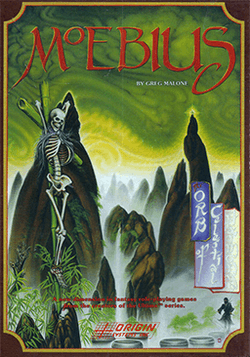Moebius: The Orb of Celestial Harmony
| Moebius: The Orb of Celestial Harmony | |
|---|---|
 Cover art | |
| Developer(s) | Origin Systems |
| Publisher(s) | Brøderbund |
| Designer(s) | Greg Malone [1] |
| Platform(s) | MS-DOS, Apple II, Amiga, Atari ST, Commodore 64, Macintosh |
| Release date(s) | 1985 |
| Genre(s) | Role-playing video game with action elements. |
| Mode(s) | Single-player |
Moebius: The Orb of Celestial Harmony is a video game produced by Origin Systems and designed by Greg Malone. It was originally released in 1985 for the Apple II series of personal computers. Versions were also released for the Amiga, Atari ST, Commodore 64, Macintosh, and MS-DOS. The game is primarily a top-down view tile-based role-playing video game, but it has action-based combat sequences which use a side view, roughly similar to games such as Karateka.
Origin Systems produced a sequel to the game, entitled Windwalker.
Gameplay
The player's objective, as disciple of the Headmaster, is to recover the Orb of Celestial Harmony from disciple-turned-badguy Kaimen. To do that, the player must train its body and soul in the best tradition of Chinese warriors: to "walk the path of Moebius the Windwalker." The action takes place on the four Elemental planes of Earth, Water, Air and Fire, which the player must traverse in order to recover the Orb. Although gameplay is similar to standard RPGs, there are some differences: in addition to familiar character statistics such as dexterity, the players also has karma, a crucial attribute that goes up or down constantly depending on his deeds. Frighten a citizen with a sword, and the karma will drop; defeat monsters in battle, and it will rise. Combat is also played in a 2D side-scrolling view similar to fighting games, having a wide range of attacks to use, even including shurikens and fireballs if the character is experienced enough.
Reception
Compute! called Moebius "yet another program worth raving about" from Origin, and a worth followup to Ultima IV. It stated that the game had excellent graphics, "challenging and functional" arcade combat, and "many hours of enjoyment" from the puzzles.[2] Computer Gaming World stated in 1986 that the game was "sort of an outgrowth or continuation of the best parts of Ultima with special emphasis on graphic detail ... The addition of a fully animated combat system was frosting on the cake".[3] The magazine stated in 1987 that the martial-arts and RPG portions of Moebius "don't fit together very well, but each is individually enjoyable".[4] The game was reviewed in 1989 in Dragon #141 by Hartley, Patricia, and Kirk Lesser in "The Role of Computers" column. The reviewers gave the game 4½ out of 5 stars.[5]
References
- ↑ "The Giant List of Classic Game Programmers". dadgum.com.
- ↑ Trunzo, James V. (July 1986). "Moebius: The Orb Of Celestial Harmony For Apple". Compute!. p. 62. Retrieved 8 November 2013.
- ↑ McPherson, Jim (Jun–Jul 1986). "Moebius". Computer Gaming World. p. 37. Retrieved 28 July 2014.
- ↑ Ardai, Charles (May 1987). "Titans of the Computer Gaming World / Part II of V: Ardai on Electronic Arts". Computer Gaming World. No. 37. pp. 28–29, 40–41. Retrieved 21 May 2016.
- ↑ Lesser, Hartley; Lesser, Patricia; Lesser, Kirk (January 1989). "The Role of Computers". Dragon (141): 72–78.
External links
- Moebius: The Orb of Celestial Harmony at MobyGames
- Moebius: The Orb of Celestial Harmony can be played for free in the browser at the Internet Archive
- Windwalker at MobyGames
- Windwalker can be played for free in the browser at the Internet Archive